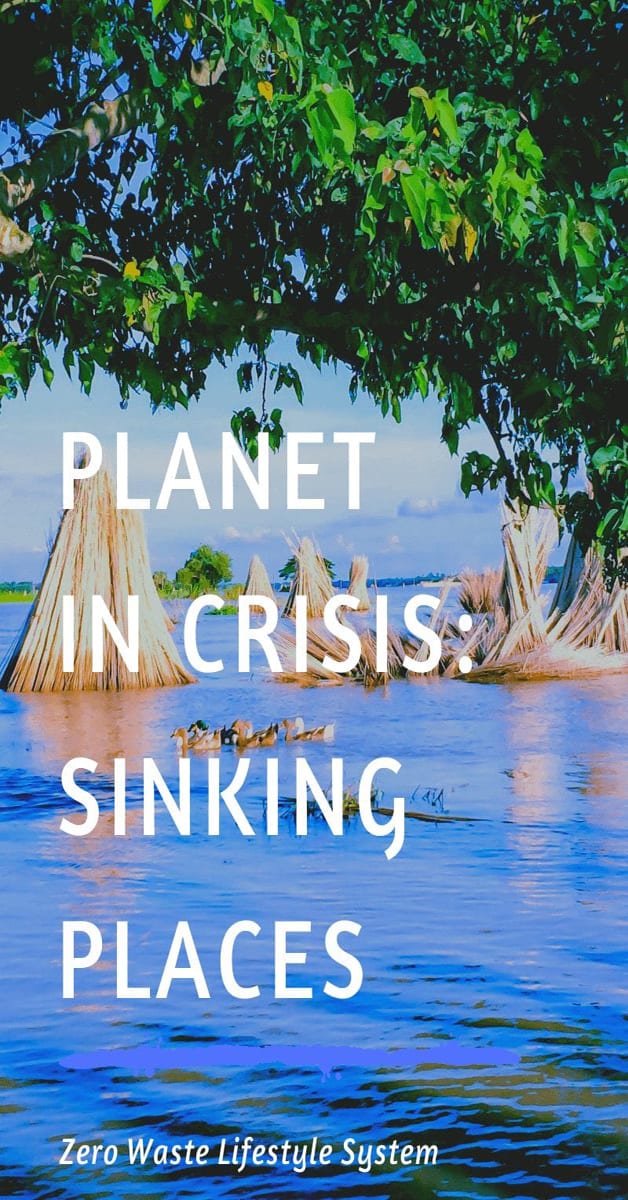Our volatile changing climate is causing lots of harsh weather conditions. Forest fires, bush fires from America to Australia. Unexpectedly severe storms, typhoons and hurricanes. Debilitating earthquakes. And worse, the melting ice caps lead to sinking places.
The boat is sinking. Or rather, Earth is slowly being swallowed up by the sea. Many suffer from water shortages while other peoples try to cope up with sinking places.
Sinking places are a historical phenomenon. One significant event related to sinking places is the Ice Age. After the Ice Age, the melting of the icecaps led to the rising sea levels which enveloped the world and changed it forever. Now history is fatally likely to repeat itself.
Scientists have long been cautioning about climate change and related phenomena such as the melting of polar icecaps, but the impact of these phenomena are not easily imagined in our daily lives. Temperatures worldwide and sea levels are increasing. Most studies predict that ocean levels will rise between 0.3 to 2.5 meters by the end of the century. Another such effect of climate change is the sinking of places which is invisible at first but eventually poses serious threats.
Causes of Flooding or Sinking Places
The phenomenon of cities sinking or “land subsidence” has both natural and human-made causes.
Natural conditions cause alluvial soils to eventually press together because of the sediments which settle above thus undergoing tectonic subsidence. The average rate of natural subsidence in uncompacted sediment areas is less than one centimeter per year. However, because of the bigger settlements around a delta, subsidence caused by groundwater extraction increases the rate to 20-30 centimeters per year.
One reasons for subsidence is human-created: heavy loading and over-extraction of groundwater, oil and gas. It is also caused by population density in urban centers because of the migration of hundreds of millions of people searching for better lives.
Effects of Sinking Places
The effects of the sinking places differ based on where they occur. The political and economic situation of the country may be considered as the impact of environmental threats may be exacerbated by unpreparedness.
In the Central Valley in the United States, the sinking has caused cracking on roads and the formation of holes in the ground. Underground pipes are also being damaged. This creates a threat for the huge farms in the region which produces ¼ of the US food supply.
The impact of land subsidence is different in Haiti. Haiti’s population depends on agriculture for livelihood so rising sea levels could greatly impact the population because of the destruction of crops due to saltwater. Natural disasters have a severe impact on Haiti which caused a fallback in the country’s economic development. The heavy deforestation on its land as well as its being mountainous makes it prone to landslides.
Another case study is Kiribati. Because of the rising sea levels, it may cease to be visible in the map. Just 6 feet above sea level, the nation’s existence is being threatened. The rising sea levels put the island’s freshwater at risk for contamination. The island is dependent on its fishing industry which would be greatly affected by climate change.
Sinking Places Around the World
After an overview of the effects of sinking places, here is a list of 17 places in danger of being submerged underwater.
1. Jakarta, Indonesia
Forty percent of Jakarta is already below sea level. This is caused by Jakarta’s infrastructure which lacks a reliable piped-in water network. Residents also use private wells to access groundwater.
Excessive groundwater pumping is causing Jakarta to sink around 6.7 inches per year. By 2050, the city is predicted to be underwater. Because 10 million citizens will be affected by the rising sea levels, a plan recently approved by the Indonesian government seeks to move capital 100 miles away. This move will take effect in about 10 years and will cost $33 billion.
2. Lagos, Nigeria
Global warming has caused the coastline of the largest city in Africa, Lagos to erode. According to a 2012 study conducted by the University of Plymouth, “a sea level rise of three to nine feet would ‘have a catastrophic effect on the human activities in these regions.’” It is expected that global sea levels will rise to 6.6 feet by 2100.
3. Houston, Texas
Certain areas in Houston constantly sink to about 2 inches per year as a result of excessive groundwater pumping. As it sinks, Houston becomes more vulnerable to natural disasters such as Hurricane Harvey which destroyed 135,000 homes and “displaced around 30,000 people”.
4. Dhaka, Bangladesh
The New York Times wrote that although Bangladesh produces merely 0.3% of all carbon emissions worldwide, it is one of the countries most affected by rising sea levels. By 2050 it is expected that 17% of Bangladesh’s land will be flooded, displacing around 18 million Bangladeshis.
5. Venice, Italy
Venice is sinking by 0.08 inches every year. During its high water season in 2019, its water levels peaked to 4 feet, 3 inches, prompting city officials to put wooden boards for people to walk on.
6. Virginia Beach, Virginia
According to a study by the National Oceanic and Atmospheric Administration, Virginia Beach may experience sea levels to rise by 12 feet by 2100.
7. Bangkok, Thailand
Anond Snidvongs of the Geo-Informatics and Space Technology Development Agency stated that most of Bangkok is below sea level and the city sinks by 1-2 centimeters annually.
8. New Orleans, Louisiana
A study conducted by NASA in 2016 found that some areas of New Orleans are sinking by 2 inches per year. It is also expected to be underwater by 2100. Some areas are already 15 feet below sea level.
9. Rotterdam, The Netherlands
The New York Times stated that only 10% of Rotterdam city is above sea level. Water parks called “Room for the River” were built by the Dutch to serve as reservoirs for water. Sea levels are expected to rise to around 1 meter by the end of the century.
10. Alexandria, Egypt
Rising sea levels have been causing the beaches in Alexandria to disappear. The NPR found that by 2100, the sea levels in the Mediterranean Sea would rise by 2 feet.
11. Miami, Florida
Jeff Goodell, an environmental author, stated that Miami cannot be imagined to continue existing by 2100. Its sea levels are rising faster than anywhere in the world causing contamination in water and damages in structures.
12. London
The glaciers of the United Kingdom have melted but the sea level in Scotland rises 0.04 inches per year and southern United Kingdom sinks to the sea.
13. Haiti
Haiti is found in the Atlantic Hurricane Basin which makes it vulnerable to hurricanes. Not many studies are certain about the real link between climate change and hurricane frequency however there is a link with wetter and more intense hurricanes.
14. Yemen
Yemen is one of the several countries to be gravely impacted by rising sea levels. Exacerbated by rising sea levels, malaria is also becoming even more common in Yemen.
15. Manila
Manila is so densely populated making evacuations difficult. The city suffers from poor infrastructure and a lack of effective drainage and sanitation systems. However, the country is being more proactive. Part of its national budget has been set aside for the agricultural sector and for the development of infrastructure to be more prepared for natural disasters.
16. Kiribati
Just 6 feet above sea level, the nation’s existence is being threatened. The rising sea levels put the island’s freshwater at risk for contamination. The island is dependent on its fishing industry which would be greatly affected by climate change.
17. United Arab Emirates
The country is at “extreme risk” of water stress as more energy would be spent on cooling. However, it has invested in the production of its own freshwater, temperature-controlled spaces, green energy and bioengineering crops to be adaptable to extreme heat.
Conclusion
Findings in climate change projects are not exact since several factors should be considered. Niall Smith spoke of the role of political and social climates in a country’s preparedness in cases of potential environmental threats.
Scientists have likewise not come to a consensus regarding whether or not investments should be made on either local or global efforts. Brian R. Silliman of Duke’s Nicholas School of Environment says that both are needed. He says that local efforts lessen the impact of climate change and pave the way for sinking cities and bleaching corals to adapt.
There are several other possible ways to handle the issue. Relocating people should be the last option.
Sustainable water management is a possible solution for the prevention of water shortage. Innovation regarding water supply is necessary to prevent the over-extraction of groundwater. Groundwater tables may also be built. Concrete characterizes urban life instead of natural parks and rivers. Effective urban planning or how cities are constructed should be considered. Shorelines must be protected by ways such as building on stilts.
Climate change undoubtedly creates a widespread impact worldwide but its gravity is felt in varying levels of intensity across the globe. Countries with widespread poverty and those with inefficient governments are at greater risk and are usually not sufficiently equipped to face the environmental threats. Sinking places is another one of these issues which can be addressed in several ways. More proactive approaches should definitely be taken.





Crazy how this is happening all over. The planet is changing massively.
Wow! So much information to process!
Thanks for the great info and interesting read!
This is crazy – I had no idea! Thanks for sharing!